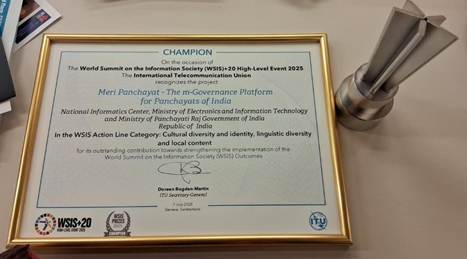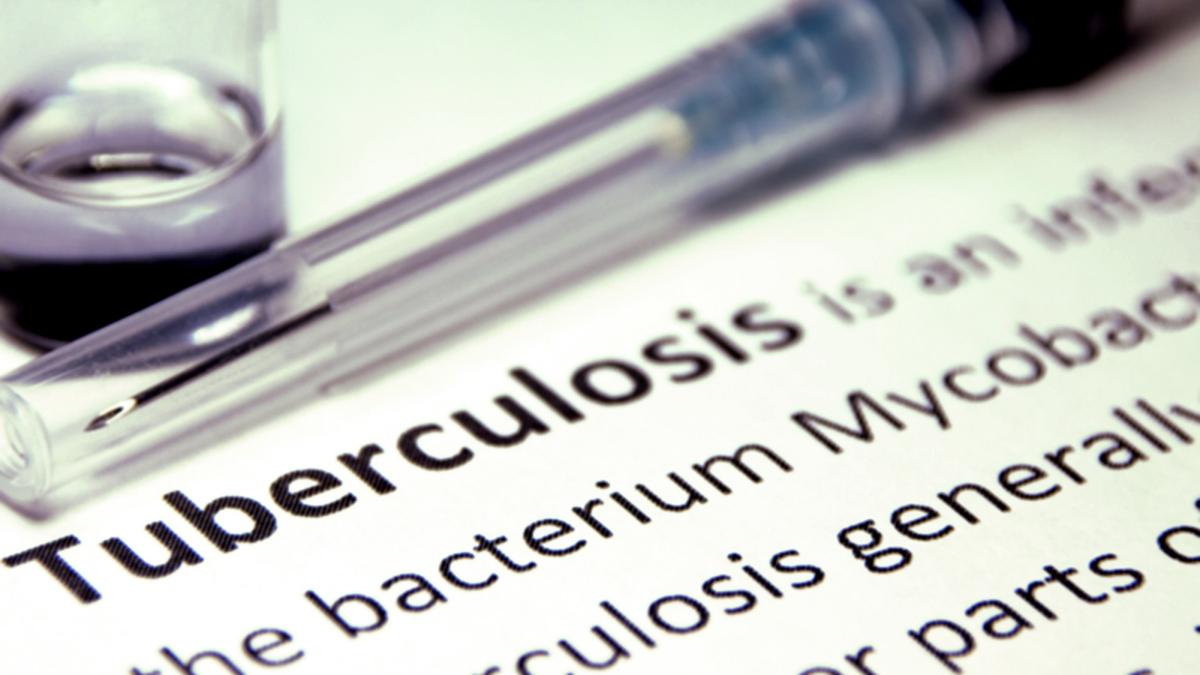Meri Panchayat App

- 22 Jul 2025
In News:
India’s digital governance model received global recognition as the Meri Panchayat mobile application won the prestigious WSIS Prizes 2025 Champion Award under the category Cultural Diversity and Identity, Linguistic Diversity and Local Content. The award was presented during the WSIS+20 High-Level Event 2025 held in Geneva, Switzerland.
Key Highlights:
- The award was conferred by the International Telecommunication Union (ITU) as part of the World Summit on the Information Society (WSIS) initiative.
- The WSIS+20 event commemorated 20 years of WSIS, providing a platform to assess digital progress, address new challenges, and promote inclusive information societies.
- The event was co-hosted by ITU and the Swiss Confederation, and co-organized by UNESCO, UNDP, and UNCTAD.
About the “Meri Panchayat” App:
- A flagship m-Governance platform developed by the Ministry of Panchayati Raj in collaboration with National Informatics Centre (NIC) under the Ministry of Electronics and IT (MeitY).
- Designed to empower 2.65 lakh Gram Panchayats, the app caters to over 950 million rural residents and 25 lakh elected Panchayat representatives.
Key Features:
- Real-time Access: Budgets, receipts, payments, and Panchayat-level development plans.
- Transparency & Accountability: Social audit tools, geo-tagged fund utilization, and grievance redressal mechanisms.
- Participatory Governance: Enables citizens to propose projects, rate completed works, and view Gram Sabha decisions.
- Multilingual Support: Interface available in 12+ Indian languages, enhancing local inclusivity.
- Weather and Civic Info: Gram Panchayat-level weather forecasts, civic services, and infrastructure details.
Significance:
- The app strengthens participatory democracy by digitally integrating rural citizens into governance.
- It aims to bridge the digital divide and promote linguistic and cultural inclusivity in rural India.
- Recognized globally for promoting citizen-centric governance and local content diversity.
Bima Sakhi Yojana
- 22 Jul 2025
In News:
Life Insurance Corporation of India (LIC) has signed a Memorandum of Understanding (MoU) with the Department of Rural Development, Ministry of Rural Development, to implement the Bima Sakhi Yojana in rural areas. The agreement was formalized during the ‘Anubhuti’ national conclave on financial inclusion held in Goa.
About Bima Sakhi Yojana:
- Implementing Body: Life Insurance Corporation of India (LIC) in collaboration with the Union Ministry of Rural Development.
- Objective: To promote financial inclusion and women empowerment by facilitating their participation in the insurance distribution sector.
- Target Group: Rural women aged 18–70 years, with at least a Class 10 qualification.
Key Features:
- Stipendiary LIC Agency Scheme:
- Women are inducted as LIC agents with all associated privileges.
- The scheme offers a monthly stipend for the initial three agency years:
- ?7,000 in the first year
- ?6,000 in the second year
- ?5,000 in the third year (Subject to performance and terms and conditions)
- Commission Benefits:
- In addition to stipends, Bima Sakhis are eligible for sales commissions.
- A commission of ?48,000 (excluding bonuses) is provided in the first year for qualifying agents.
- Training & Career Path:
- Selected candidates undergo specialized training to build capacity in insurance awareness and financial literacy.
- Post-training, they function as LIC agents.
- Graduates among them may be eligible to become LIC Development Officers.
- Scale of Implementation: The scheme aims to appoint 2 lakh Bima Sakhis over a period of three years, with focus on enhancing rural outreach and insurance penetration.
Eligibility Criteria:
- Age Limit: 18 to 70 years
- Minimum Education: Must have passed Class X
- Preference: Women from rural areas are prioritized
Ineligibility Conditions:
- Women who are:
- Related to existing LIC agents or employees (including spouse, children, siblings, parents, and in-laws)
- Retired LIC employees or ex-agents
- Currently working as LIC agents
Significance:
- Promotes gender empowerment and financial literacy in rural India.
- Part of government’s push for inclusive financial growth through public-private partnerships.
- Illustrates convergence between LIC’s social responsibility and government rural development goals.
Hatti Tribe
- 22 Jul 2025
In News:
Recently, two brothers from the Hatti tribe in the Trans-Giri region of Sirmaur district, Himachal Pradesh, married the same woman under the traditional custom of polyandry. The wedding, held in Shillai village, was conducted openly and witnessed by hundreds, reviving attention to this rare tribal practice.
About the Hatti Tribe
- The Hatti community derives its name from the traditional occupation of selling agricultural produce, meat, and wool in local markets called haats.
- They reside primarily in the Himachal–Uttarakhand border region, especially in the basins of the Giri and Tons rivers, both tributaries of the Yamuna.
- The Hattis are divided into two major groups:
- One in Trans-Giri, Sirmaur district (Himachal Pradesh)
- Another in Jaunsar-Bawar (Uttarakhand)
- They maintain similar cultural practices, and intermarriage between these clans is common.
- The community follows a traditional council system called ‘Khumbli’ for resolving social issues.
- As of 2023, the Hatti tribe in Himachal Pradesh was granted Scheduled Tribe (ST) status, while Jaunsar-Bawar in Uttarakhand received tribal status in 1967.
- Their economy is largely agrarian, with a focus on cash crops due to favorable climatic conditions.
The Tradition of Polyandry ("Jajda")
- Polyandry in the Hatti community is locally called “Jajda” and was historically practiced to prevent division of ancestral land.
- The ritual includes a marriage procession of the bride to the groom’s village and a ceremony called “Seenj”.
- Local priests chant mantras in the native language and conclude the ceremony with blessings and offerings like jaggery.
- This practice has declined in recent decades due to increasing literacy among women, social modernization, and economic shifts.
Legal and Social Acceptance
- Polyandrous marriages are informally recognized under Himachal Pradesh revenue laws, where the practice is referred to as “Jodidara”.
- Though rare, such marriages continue to be socially accepted in some remote villages of Trans-Giri, Kinnaur, and Jaunsar-Bawar.
Demographics
- As per the 2011 Census, the Hatti population was around 2.5 lakh, and estimates now suggest about 3 lakh people across 450 villages in the Trans-Giri region alone.
Cultural and Practical Rationale
According to Hatti elders and community leaders:
- Land Preservation: Prevents fragmentation of ancestral property.
- Joint Family Bonding: Promotes unity and mutual understanding among brothers.
- Labor Sharing: Ensures adequate manpower to manage scattered agricultural lands in hilly terrain.
- Security: A larger family offers greater social and economic protection in tribal settings.
Cy-TB Test

- 22 Jul 2025
In News:
Kerala has introduced Cy-TB, a new intradermal diagnostic tool, under the National TB Elimination Programme (NTEP) to identify and manage latent tuberculosis infections (LTBI).
What is the Cy-TB Test?
- Cy-TB is a third-generation skin test approved by the Central TB Division, Government of India.
- It involves the intradermal injection of 0.1 ml of Mycobacterium tuberculosis-specific antigens (ESAT-6 and CFP-10) into the inner forearm.
- If an individual develops a raised area of 5 mm or more within 48–72 hours, it indicates TB infection.
- The test is:
- Highly specific, accurate, and user-friendly
- Administered by a trained nurse
- Requires follow-up for reading the result
- A cost-effective alternative to the Interferon Gamma Release Assay (IGRA), which requires lab support
TB Infection vs. Active TB Disease
- TB infection means that a person harbours Mycobacterium tuberculosis bacteria in a dormant form and shows no symptoms.
- These individuals are not contagious.
- If left untreated, about 5–10% may progress to active TB when their immune system weakens.
Why Focus on Latent TB?
Kerala is prioritising treatment of latent TB infections as part of its last-mile strategy in TB elimination. Despite a 40% reduction in TB transmission over six years, the state faces challenges due to subclinical (asymptomatic) TB and a high burden of comorbidities such as diabetes, chronic kidney disease, and alcohol abuse.
Key Study in Thiruvananthapuram (2022)
- A cross-sectional community study found that 20.5% of adults had TB infection.
- Prevalence increased with age, from 11.5% (18–35 years) to 30.3% (above 58 years).
- State-level estimates suggest around 22% of Kerala’s general population is latently infected.
Burden of Tuberculosis (India & Global)
According to the WHO Global Tuberculosis Report 2024:
- India accounts for 26% of global TB cases – the highest worldwide.
- TB continues to be the leading infectious disease killer.
- Each year, around 10 million people fall ill globally, and 1.5 million die of TB.
- TB is the top cause of death among people with HIV and a major driver of antimicrobial resistance (AMR).
Implementation of Cy-TB in Kerala
- The Cy-TB test will be used in district TB centres, taluk hospitals, dialysis centres, and some block-level facilities.
- It will also be used to screen residents of old age homes, especially where pulmonary TB cases have emerged.
- The test is also available in major private hospitals.
High-Risk Groups for Preventive Therapy
Only high-risk individuals who test positive for latent TB are recommended for TB preventive therapy (TPT). These include:
- People on dialysis or awaiting transplants
- Patients on immunosuppressive or anti-TNF therapy
- Individuals with silicosis
- Healthcare workers exposed to TB
- Elderly in institutional settings
Preventive TB Treatment Regimens
- 3HP: 3 months of weekly doses of Isoniazid and Rifapentine
- 6H: 6 months of daily Isoniazid. These regimens use fewer drugs and are shorter than active TB treatment protocols.
Guryul Ravine Fossil Site
- 22 Jul 2025
In News:
The Geological Survey of India (GSI) has raised an alarm over a serious threat to the Guryul Ravine fossil site located in Khonmoh, on the outskirts of Srinagar, Jammu & Kashmir. The site holds immense geological significance and is facing the risk of degradation due to human activity.
About the Site
The Guryul Ravine is situated near Khonmoh in Jammu & Kashmir, close to the Dachigam National Park. Geologically, the area is part of the Vihi district. It falls within the ecologically sensitive Khonmoh Conservation Reserve.
- This fossil site is globally significant because it contains sedimentary layers that preserve evidence of the Permian–Triassic mass extinction event. These geological layers date back around 260 million years and represent one of the most catastrophic periods in Earth’s biological history.
- Remarkably, the site also shows signs of what is believed to be the world’s earliest recorded tsunami, with the imprint still visible in the exposed strata.
Significance of the Permian–Triassic Extinction Event
- Also referred to as the “Great Dying,” the Permian–Triassic extinction event occurred around 251.9 million years ago. It marks a major boundary between the Permian and Triassic geological periods and also separates the Paleozoic and Mesozoic eras.
- This event was the most severe extinction episode in Earth’s history. It led to the loss of nearly 90–95% of marine species and about 70% of terrestrial vertebrate species. The extinction dramatically reshaped life on Earth and paved the way for the rise of dinosaurs in the subsequent Mesozoic era.
Conservation Concerns
- The GSI has warned that this invaluable geo-heritage site is under threat due to encroachment and unregulated activities. It has recommended urgent steps to protect the fossil-rich area to preserve its scientific and educational value.
